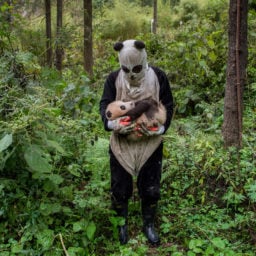After more than a century of covering the Earth’s manifold splendor and diverse peoples through distinctly Western eyes, leaving it open to charges of colonialism (if not outright racism), National Geographic has now turned its lens on itself.
The magazine’s special April issue is dedicated to examining the subject of race from a variety of angles: theories of the social construction of race, the racial profiling of black motorists, the present-day renaissance of historical black colleges, the mounting tensions triggered by the demographic shifts in the nation, and even Brazilian artist Angélica Dass‘s project “Humanae,” which pairs over 4,000 people from around the world with different Pantone color swatches. Yet National Geographic editor Susan Goldberg’s letter introducing the issue has made the biggest splash, with its blunt admission: “For Decades, Our Coverage Was Racist. To Rise Above Our Past, We Must Acknowledge It.”
Given National Geographic’s status as an icon of mainstream taste and its role in shaping how generations have viewed the world, the magazine’s mea culpa has been something of an event. Over the last week, Goldberg’s letter has gained widespread media attention and been debated across social media—which makes sense, considering that the 130-year-old magazine also claims to be the world’s biggest social media brand, boasting a staggering 350 million followers across various platforms, and thus a huge ability to shape public conversation.
National Geographic’s self-examination chimes with a larger trend of legacy media properties reexamining their historical blind spots, including the New York Times’s recent project of writing obituaries for women overlooked by the Paper of Record in their time. And while the “Race Issue” has not been without criticism—particularly of its cover story, which uses fraternal twins who have different skin colors to make the point that race is a social construct—the sheer amount of attention that the gesture has garnered means that it is likely to inspire more similar gestures.
The research that formed the basis of Goldberg’s letter was done by John Edwin Mason, who teaches African history and the history of photography at the University of Virginia, in the College and Graduate School of Arts and Sciences. A specialist in both the culture of South Africa and the Civil Rights photographer Gordon Parks, Mason was given the mandate to dig into the National Geographic archive to assess the magazine’s history in anticipation of the April issue.
I spoke with Mason about his research process, the historical context that shaped National Geographic, and how the social movements of the 1960s slowly transformed its coverage—just as, little by little, the social movements of the present seem to be reshaping its coverage today.
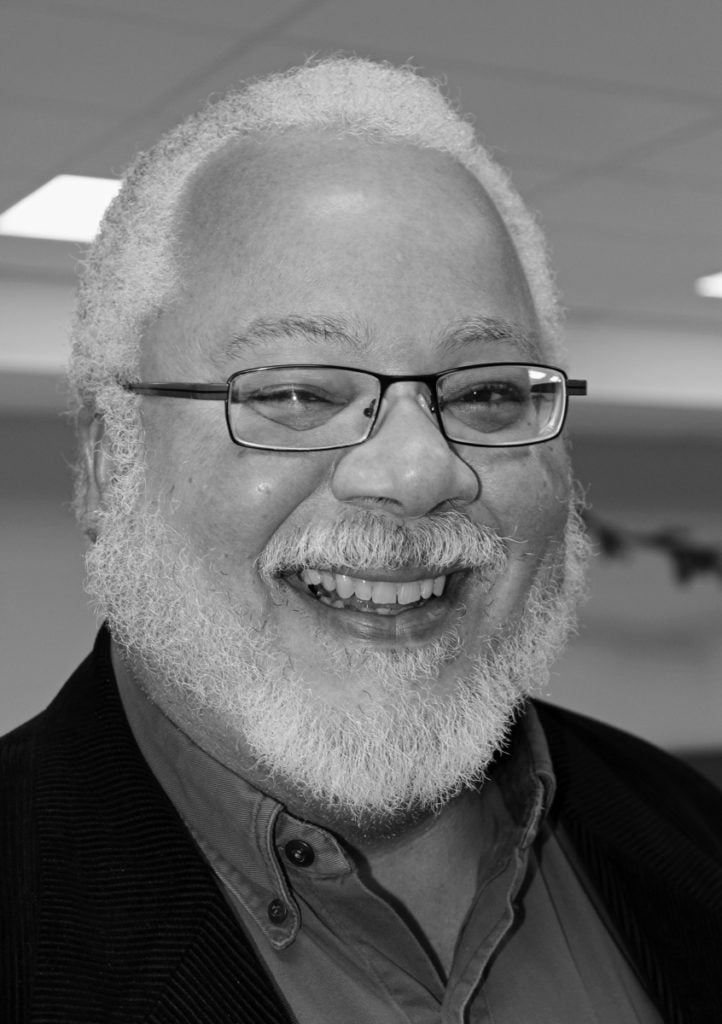
Photography historian John Edwin Mason. Image courtesy John Edwin Mason.
Let’s start with the question of why you think this has been such a big deal.
When Susan Goldberg asked me to do this, and told me about this special issue on race, I thought that it was going to get a lot of attention. It has really great people writing for it. I know some of the photographers, and they’re fantastic. And I also knew that these are people who are not going to pull their punches—they’d pull their story before they pull their punches! “This issue is going to make some waves”—that was my thinking.
So I went off and did the research, and the issue was published—and the focus has been entirely on Susan Goldberg’s letter. It’s not on the issue itself, which I think deserves a little more attention than it’s been getting.
And I was surprised. I didn’t reckon with how emotionally invested people are in National Geographic. I think it’s because so many of us, even those of us who grew up African American like myself, experienced this magazine as part of our childhoods. We consumed it pretty uncritically.
National Geographic took me places I’d never been and probably will ever go; it showed me strange things from around the world. I mean, I became a historian of Africa. Did National Geographic play some kind of role in that? Probably. I wanted to go to some of those places I saw in the magazine and meet those people.
Some of that popular investment has to do with the power of its photography, right?
I think it’s more than that. You know, when I was growing up, in the mid- to late-‘60s and into the ’70s, the photography was OK—but it got much, much better later. The real allure was what they were showing.
I believe it was the first magazine to go full color.
For sure, the photography always sold the magazine. They were using color very early on, even when it was a very, very expensive process. Before World War II, before Kodachrome, National Geographic was dazzling, like Life only better in terms of the paper stock that they were using and the reproduction of the photographs. And humans are visual. We really, really like to look.
What was the brief that you were given?
It was really open-ended: Go into our archives, find stuff that has to do with the way that the magazine presented race, people of color, Asia, Africa, Latin America, to its readers; then come back and tell Susan Goldberg, the editor, about it.
And, look, I’m a historian. When a private institution like National Geographic says, “Come visit our archives,” that’s the best thing.
But going to their archives was important for the research, because I wanted to see the unpublished photographs. As you know, when a photographer goes off on assignment, he or she is going to come back with many, many more photos than ever get published. Looking at the slides or at the contact sheets or at the work prints can let you get a sense of what the photographer was seeing, what the photographer was not seeing, what the photographer was trying to make happen—because in the age before journalistic or documentary ethics were fully formed, many photographs were staged. You get a sense of how a visual scene was put together.
So I really appreciated the time in the archives. But I couldn’t spend all my time in Washington, DC. I had classes to teach and other writing to do, and so the bulk of the research I did was at the UVA library where, in bound volumes, we have each and every issue of National Geographic since it began publishing in the 1880s.
I couldn’t look at all of that material. So I said, OK, I’m going to poke around in the pre-World War II period—a bit. Poking around is too informal a term. I systematically read select years.
![Pictured: Photographs by C.P. Scott [left] and H.E. Gregory. In a full-issue article on Australia that ran in 1916, aboriginal Australians were called “savages” who “rank lowest in intelligence of all human beings.” Image courtesy National Geographic.](https://news.artnet.com/app/news-upload/2018/03/national-geographic-race-issue-1024x682.jpg)
Pictured: Portrait of C.P. Scott [left] and H.E. Gregory. In a full-issue article on Australia that ran in 1916, aboriginal Australians were called “savages” who “rank lowest in intelligence of all human beings.” Image courtesy National Geographic.
Yes. But I was really most interested in the post-World War II period, for two reasons. The first is that living Americans were shaped by the post-World War II issues, and the second is that the post-World War II era is when America emerges as the dominant world superpower. It is the era of the Civil Rights movement, which was likely to have an impact on the way that the magazine depicted people of color. It’s also the era of decolonization in Africa and Asia.
These factors would have to shape the way that the magazine shows the world—and they did, though not exactly in the ways that I expected.
To the general public, I’d say that the term “National Geographic photography” is already a kind of shorthand for a certain style of popular ethnographic photography. What was it that you found that surprised you?
National Geographic in many ways sets the standard for what I call reportage photography. That’s been increasingly the case since the 1970s, when there was a real uptick in the quality of photography appearing in the magazine. But there was always a general style of National Geographic photography: National Geographic photography rarely has an edge. National Geographic photography rarely challenges the viewer.
You mean that it doesn’t give readers something that they wouldn’t have already expected from a place?
Things that they wouldn’t have expected in terms of exoticism or strangeness are OK. But things that they would not have expected in a sociological or political sense, not so much.
What I found was an absence that I didn’t expect to be quite so total. I was looking intensively at the period of decolonization. What I saw almost entirely missing was any sense that anti-colonial struggles were building and that nationalist sentiment was growing in Asia and Africa. I saw almost no signs of modern cosmopolitan Africans or the working class or the intellectuals who were driving these movements. I saw few signs of urbanizing Africa. I saw few signs of Africans making connections between each other on the continent or looking to anti-colonial and anti-racist movements across the globe.
Anyone who read National Geographic would have been gobsmacked by the emergence of new nations, and totally unprepared to understand why this was happening. I expected National Geographic to be ambivalent. I didn’t expect National Geographic to ignore these movements almost completely. That really was something of a surprise.
Those struggles were very much a part of the Civil Rights conversation in the US: Martin Luther King going to Africa, speaking about its transformation in his sermon “The Birth of a New Nation.”
Even Richard Nixon was present at the birth of Ghana! Foreign policy elites were very concerned about courting these new nations. It was a complicated relationship, because Britain and France, the colonizing nations, were also our allies. Nevertheless, other media showed a strong awareness that these things were happening.
I know Life magazine very, very well, because I’m writing a book about Gordon Parks and I’m writing an article about Life’s representation of Africa. Life paid a lot of attention. Not all of it good, but also not all of it bad.
I was just reading your essay about Life where you talk about how, in the face of the Cold War and Civil Rights struggles, the magazine’s tone reflected a kind of a compromise.
There was an uncomfortable ambivalence in Life. After all, Life was almost entirely produced by white Americans who had grown up and were comfortable with a very segregated society, and many had their doubts about the fitness of African Americans or African people and Asian people for self-government and self-rule.
On the other hand, Life was also full of people who were uncomfortable with segregation and who did believe that African Americans had gotten a raw deal and that maybe colonization had its problems. There’s a reason why the magazine hired Gordon Parks, right? It didn’t hire two Gordon Parks. He was the one and only African American on the editorial staff for a very long time. But at least he was there.
So Life was deeply ambivalent. With National Geographic, you don’t sense that ambivalence at all.
In fact, you see the enthusiastic embrace of European and American colonialism, because, by the way, we also had colonized the Philippines and Puerto Rico and Hawaii and the entire continental United States. National Geographic was very comfortable with the commonsense notion that the white man by right gets to dominate the globe, that rule by North American and Western European powers simply makes sense. This state of affairs was seen as the natural working out of the laws of human development that placed white people on top, and especially Western Europeans and Americans, who had a responsibility, at best, to lift the Asian or African masses out of darkness and into the light of civilization—because of course those peoples couldn’t do it on their own. They needed help and guidance.
So National Geographic is less ambivalent than Life, but actually less ambivalent in the direction of being more comfortable with colonialism?
Exactly. They embraced the colonialist vision of the world until well after World War II. I think that what’s happening in the ’50s is that they’re plugging their ears and shutting their eyes. They don’t want to know about colonization, and they don’t want to know about nationalist movements, like a child sticking his fingers in his ears and going, “La la la la la.”
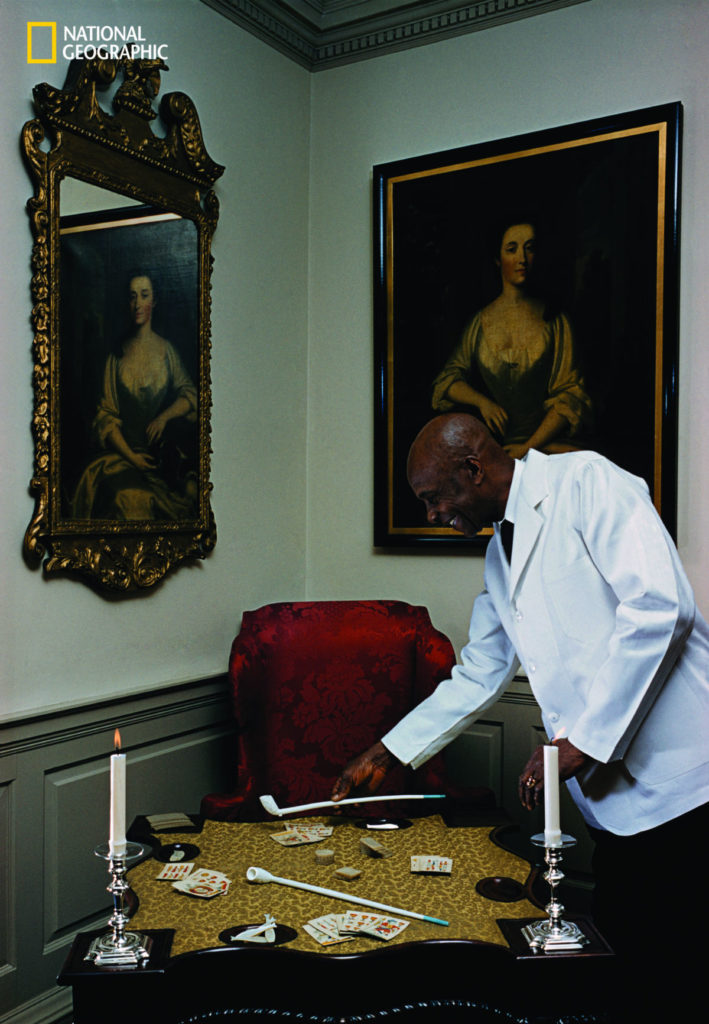
“Cards and clay pipes amuse guests in Fairfax House’s 18th-century parlor,” reads the caption in a 1956 article on Virginia history. Although slave labor built homes featured in the article, the writer contended that they “stand for a chapter of this country’s history every American is proud to remember.” Photograph by Robert F. Sisson and Donald McBain. Image courtesy National Geographic.
Do you see this as a conscious editorial policy or an unconscious bias, or a mix of the two?
It’s a mix. It does make a difference that National Geographic came at a moment when the US was becoming a global power. It starts in the late 19th century, the era of America building an overseas empire. It is also the time when elites in Western Europe and North America divided the world into the white world and the “darker races.” All sorts of foreign relations were racialized; they only cease to be so with the coming of the Cold War.
The people who put out National Geographic were intimately connected to the world of corporate and political elites. National Geographic and its editors courted presidents, vice presidents, Supreme Court justices, members of Congress, and were sometimes related to them.
They were also fabulously wealthy. National Geographic‘s longtime editor [Gilbert Hovey Grosvenor, editor from 1899–1954] was Alexander Graham Bell’s son-in-law. Graham Bell had made pots and pots of money through his telephone monopoly. Another longtime editor [Melville Bell Grosvenor, editor from 1957–67] was the son of the son-in-law. So it’s almost a family concern for a long time, and they were very wealthy and very elite and very comfortable in those worlds.
Part of the change in National Geographic that begins in the late ’60s early ’70s is due to an editorial change. Although, part of it was also that the Civil Rights movement and decolonization were finally catching up with it.
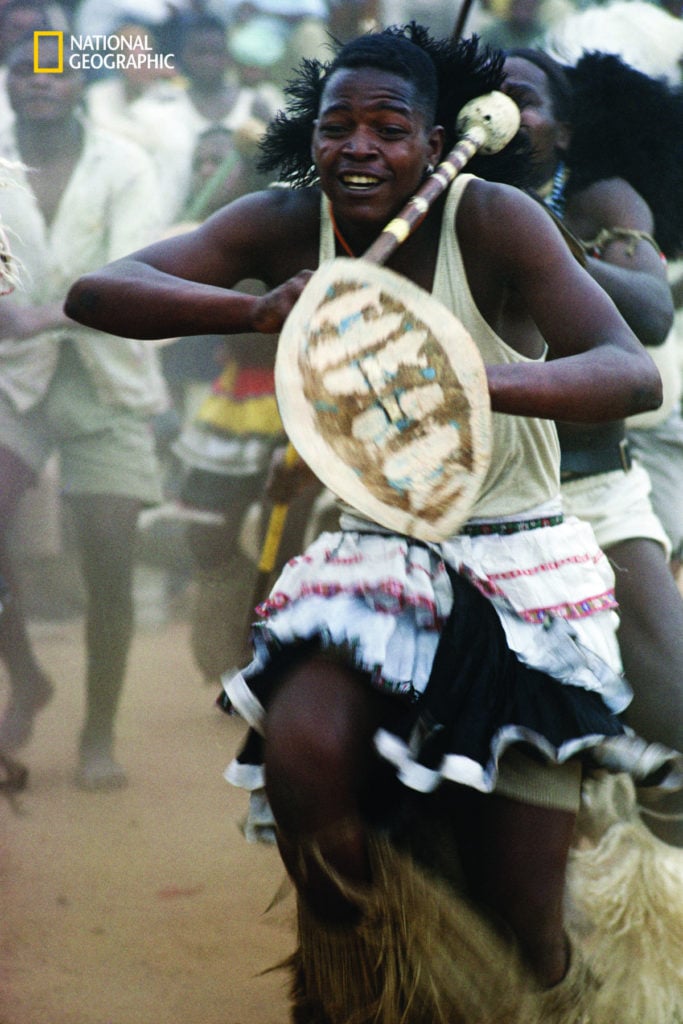
South African goldminers were “entranced by thundering drums” during “vigorous tribal dances,” a 1962 issue reported. Photograph by Kip Ross. Image courtesy National Geographic.
Susan Goldberg mentions the two stories about South Africa, one from 1977 and one from 1962 in which Apartheid isn’t mentioned at all.
The ’62 article is appalling in so many ways. It sees South Africa only through the eyes of white South Africans; it is not at all critical of Apartheid, notoriously one of the most brutal forms of white supremacy the world has ever known; and it comes more or less right after the Sharpeville Massacre, where 69 people at a peaceful nonviolent protest were shot and killed by the police, and many others were wounded. It comes at a time when the anti-Apartheid struggle in South Africa is global news. Nelson Mandela’s name is well known. The African National Congress is a well known freedom movement.
I can’t help but keep drawing parallels with Life. Life had a very strong anti-Apartheid article [“South Africa and Its Problem“] that was almost entirely done by Margaret Bourke-White in 1950. Bourke-White was a really good journalist who doesn’t get the credit she deserves. She went to South Africa, and she was horrified, really horrified by what she saw. I’ve read the letters that she wrote after her trip. Flames come off the page. The Life magazine photo essay doesn’t have that anger, because the editors didn’t publish the stronger photos, but Bourke-White’s essay is still really intense and it stands up after 50 years. I mean, it says what South Africa was all about: racial oppression and class exploitation. It’s really something, almost neo-Marxist.
Then, after the Sharpeville massacre, Life did two stories. The first one was just about the horror of the event, with really powerful Ian Berry pictures of people fleeing for their lives. A week later they published Peter Magubane’s famous funeral picture of just rows of caskets, with Anglican priests saying prayers over them.
I think this is a really important point: It’s not just that National Geographic reflected the blindnesses and default white view of its time. It was actually behind the times, even relative to its peers.
I’ve listened to interviews with the National Geographic photographers. Some were completely on board with the way that that National Geographic operated and saw the world, and you’ll hear them describing going out on assignment and looking to take pictures that showed people living a life that might have been lived 500 years ago. They consciously wanted to place their subjects in this timeless unchanging past.
But you’ll hear other interviews with the National Geographic staff photographers who would say, “Man, we hated that shit.” In fact, I heard one recently speaking about that 1962 article. The photographer essentially says that it was shameful, and that the staff at the time was aware. He says, “We were young, we were rebellious, but we were being edited by old white guys”—and, of course, they’re all white guys, but their editors were old men in their 60s.
There was a sense of generational conflict going on, of internal dissent. I tend to talk in sweeping terms about National Geographic‘s corporate culture, but it’s important to say that there was internal dissent.
In fact, if we were looking for the changes in the 1970s, it may be also a generational change. In the ‘70s, there was a new editor-in-chief and I’m sure new subordinate editors, and I think that undercurrent of dissent is what begins the process of change.
Did your brief end in the ’70s essentially?
No, I took it up into the 21st century.
And you do see a shifting in the magazine over time?
I mean, it’s gradual, and sometimes it’s one step forward, two steps back, like all change. The magazine in the ‘70s is not what it was in the ‘60s. The same thing can be said about the ‘90s and into the present.
Susan’s letter is not the start of something; it’s a culmination of changes that have already happened. It’s making explicit the critique of the magazine, where I think the magazine has been privately or implicitly critiquing itself for some time now.
The challenge for the magazine going forward is: now what do you do?
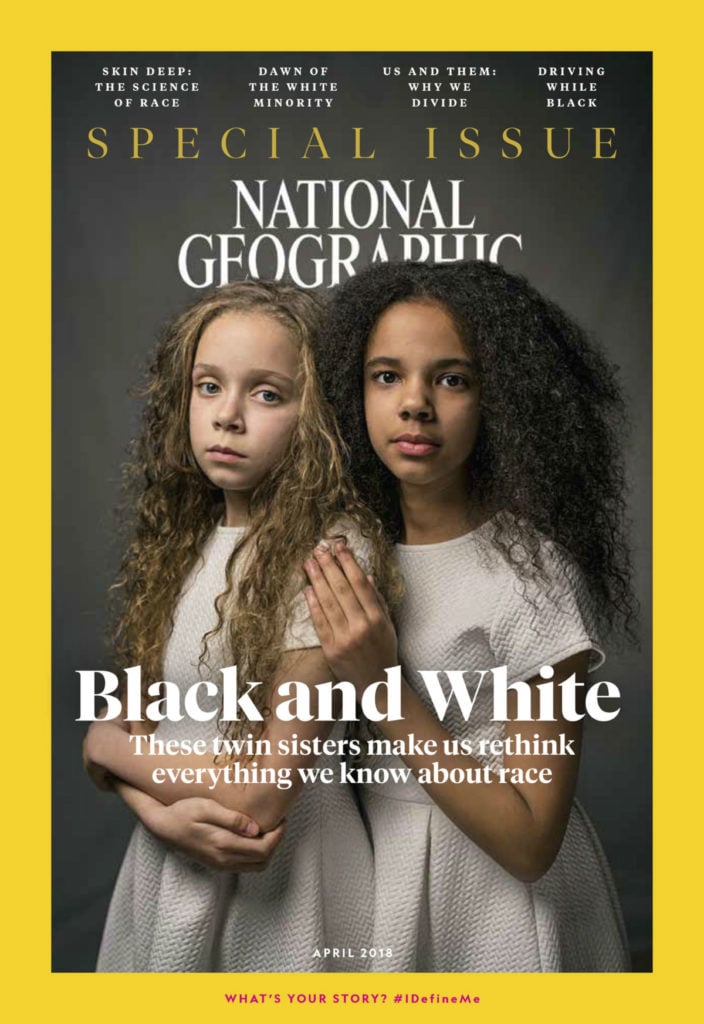


![Pictured: Photographs by C.P. Scott [left] and H.E. Gregory. In a full-issue article on Australia that ran in 1916, aboriginal Australians were called “savages” who “rank lowest in intelligence of all human beings.” Image courtesy National Geographic.](https://news.artnet.com/app/news-upload/2018/03/national-geographic-race-issue-1024x682.jpg)



